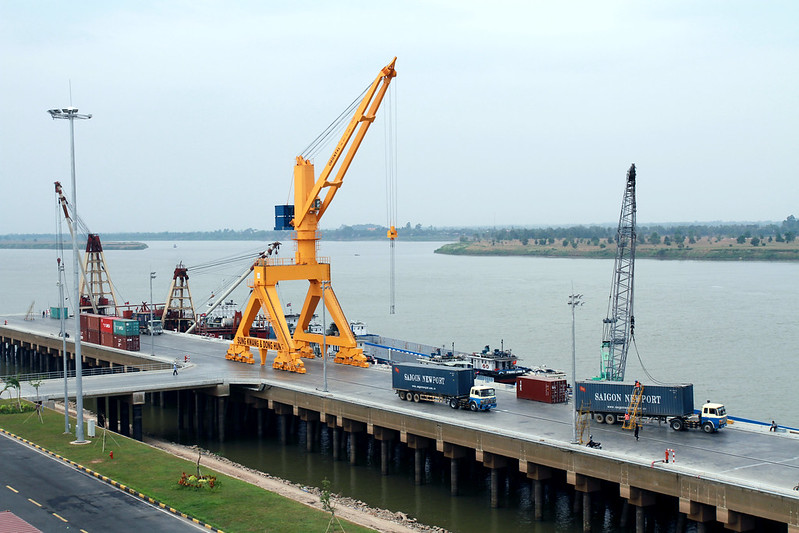តម្លៃសរុបនៃពាណិជ្ជកម្មអន្តរជាតិរបស់កម្ពុជាមានចំនួន ៣៥,៨ ពាន់លានដុល្លារនៅឆ្នាំ២០២០ ដែលកើនឡើង ២,៥ ភាគរយបើធៀបនឹង ៣៤,៩ ពាន់លានដុល្លារនៅឆ្នាំ២០១៩ បើទោះបីជាជំងឺឆ្លងកូវីដ-១៩ បានធ្វើអោយពាណិជ្ជកម្មពិភពលោកថយចុះក៏ដោយ នេះបើយោងតាមរបាយការណ៏របស់ក្រសួងពាណិជ្ជកម្មឆ្នាំ២០២០។ ប្រភពនៃការនាំចូលរបស់កម្ពុជាសំខាន់ៗក្នុងឆ្នាំ២០២០ គឺបណ្តាប្រទេសអាស៊ាន ចិន និងសហភាពអឺរ៉ុប។1

ផលិតផលពីប្រទេសវៀតណាមបានមកដល់កំពង់ផែស្វយ័តភ្នំពេញដែលស្ថិតនៅក្នុងខេត្តកណ្តាល។ រូបភាព ដោយធនាគារពិភពលោក ថតនៅថ្ងៃទី២៣ ខែកុម្ភៈ ឆ្នាំ២០១៣។ ក្រោមអាជ្ញបណ្ណ CC BY-NC-ND 2.0។
អគ្គនាយកបច្ចេកទេស ធនាគារជាតិនៃកម្ពុជា លោកជំទាវ ជា សិរីបានមានប្រសាសន៍ថាស្ថានភាពដែលល្អប្រសើរនោះ គឺការនាំចេញច្រើនជាងការនាំចូលប៉ុន្តែដោយសារតម្រូវការក្នុងស្រុកមានកម្រិតខ្ពស់ ប្រទេសកម្ពុជានាំចូលច្រើនជាងការនាំចេញ។2 ការនាំចូលរបស់កម្ពុជាមានតម្លៃ ១៨,៦ ពាន់លានដុល្លារនៅឆ្នាំ២០២០ ដែលធ្លាក់ចុះ ៧,៨ ភាគរយបើប្រៀបធៀបនឹងឆ្នាំ២០១៩ ខណៈការនាំចេញបានកើនឡើង ១៦,៧ ភាគរយដែលកើនឡើងពី ១៤,៧ ពាន់លានដុល្លារក្នុងឆ្នាំ២០១៩ ដល់ ១៧,២ ពាន់លានដុល្លារនៅឆ្នាំ២០២០ នេះបើយោងតាមរបាយការណ៍របស់ក្រសួងពាណិជ្ជកម្ម។3
វាយនភ័ណ្ឌ
ឧស្សាហកម្មវាយនភ័ណ្ឌដើរតួនាទីយ៉ាងសំខាន់ក្នុងការរីកចម្រើននៃសេដ្ឋកិច្ចកម្ពុជា។ កម្ពុជាមានភាពងាយស្រួលក្នុងការផលិតវាយនភ័ណ្ឌដែលមានគុណភាពល្អ និងតម្លៃថោកជាងបើប្រៀបធៀបទៅនឹងប្រទេសមួយចំនួនដោយសារតែកម្លាំងពលកម្មច្រើន ធនធានធម្មជាតិ និងការគាំទ្រពីរដ្ឋាភិបាល។ ប្រទេសកម្ពុជាភាគច្រើននាំចូលវត្ថុធាតុដើមសម្រាប់វាយនភ័ណ្ឌពីប្រទេសចិនហើយនាំចេញផលិតផលដែលបានបញ្ចប់ទៅកាន់ប្រទេសជាច្រើនទៀត។ ប្រទេសកម្ពុជានាំចូលបាន ៦០,៥ ភាគរយនៃការនាំចូលវាយនភ័ណ្ឌសរុបរបស់ខ្លួនដែលមានតម្លៃ ៣,៧ ពាន់លានដុល្លារពីប្រទេសចិនក្នុងឆ្នាំ២០១៩។ ប្រទេសសំខាន់ៗបន្តគឺ វៀតណាម (៨៥០ លានដុល្លារ) ហុងកុង (៣៦៥ លានដុល្លារ) និងតៃវ៉ាន់ (៣៦២ លានដុល្លារ)។4 តួលេខរបស់ក្រសួងពាណិជ្ជកម្មបង្ហាញថាប្រទេសកម្ពុជាបាននាំចូលវត្ថុធាតុដើមវាយនភ័ណ្ឌតម្លៃ ៥ ពាន់លានដុល្លារក្នុងឆ្នាំ២០១៩ ដែលជាការធ្លាក់ចុះ ១៣,៣ ភាគរយមកនៅត្រឹម ៤,៤ ពាន់លានដុល្លារនៅឆ្នាំ២០២០។5
លោកនាយករដ្ឋមន្ត្រី ហ៊ុន សែន បានថ្លែងនៅក្នុងសុន្ទរកថាមួយនៅខេត្តពោធិ៍សាត់ថា ប្រទេសចិននឹងបញ្ជូនវត្ថុធាតុដើមវាយនភ័ណ្ឌមកកាន់កម្ពុជាដើម្បីកាត់បន្ថយការខ្វះខាតដែលបណ្តាលមកពីជំងឺឆ្លង។ ការដឹកជញ្ជូននឹងបន្តរហូតដល់រយៈពេល ៥ ខែទោះបីជាគេមិនទាន់ច្បាស់ថាប្រទេសចិននឹងអាចផ្គត់ផ្គង់បានប៉ុន្មានក៏ដោយ។ យោងតាមស្ថានទូតចិនប្រចាំនៅកម្ពុជាបានឲ្យដឹងថា ទំនិញវត្ថុធាតុដើមដំបូងបានមកដល់នៅថ្ងៃទី៩ ខែមីនាឆ្នាំ២០២០ នៅកំពង់ផែស្វយ័ត ក្រុងព្រះសីហនុដូចដែលបានគ្រោងទុក។6
គ្រឿងអេឡិចត្រូនិក និងសម្ភារៈអគ្គិសនី
តម្លៃសរុបនៃការនាំចូលគ្រឿងអេឡិចត្រូនិក និងសម្ភារៈអគ្គិសនីបានធ្លាក់ចុះពី ២,៥ ពាន់លានដុល្លារក្នុងឆ្នាំ២០១៩ មក ២,៤ ពាន់លានដុល្លារនៅឆ្នាំ២០២០ ដែលជាការធ្លាក់ចុះ ៣,៧ ភាគរយដោយផ្អែកលើទិន្នន័យរបស់ក្រសួងពាណិជ្ជកម្មឆ្នាំ២០២០។7 មុខទំនិញសំខាន់ៗដែលរួមបញ្ចូលនៅក្នុងឧស្សាហកម្មនេះគឺឧបករណ៍បញ្ជូនសម្រាប់វិទ្យុ ទូរស័ព្ទនិងទូរទស្សន៍ ខ្សែភ្លើងអ៊ីសូឡង់ និងឧបករណ៍បំលែងអគ្គិសនីព្រោះការនាំចូលសរុបនៃមុខទំនិញទាំងនេះមានចំនួន ៤២២ លានដុល្លារ ២១៦ លានដុល្លារ និង ១០៤ លានដុល្លារ។8
យោងតាមលោកស្រី Marie Yang មន្ត្រីក្រសួងពាណិជ្ជកម្ម ការបញ្ចុះពន្ធនាំចូលនៃឧបករណ៍ និងគ្រឿងបន្លាស់គឺជាការចាំបាច់ដើម្បីទាក់ទាញការវិនិយោគពីបរទេសបន្ថែមទៀតព្រោះពន្ធខ្ពស់មានន័យថាថ្លៃដើមផលិតកម្មខ្ពស់ដូច្នេះវាអាចកាត់បន្ថយការប្រកួតប្រជែងរបស់កម្ពុជា។ ពន្ធនាំចូលលើផលិតផលទាំងនេះគឺខ្ពស់រហូតដល់ ១៥ ភាគរយ ខណៈដែលប្រទេសជិតខាងរួមទាំងវៀតណាម និងថៃកំណត់ពន្ធត្រឹមតែ ៣ និង ៥ ភាគរយ។9
រថយន្ត
យោងតាម Atlas of Economic Complexity ប្រភពនាំចូលរថយន្តសំខាន់ៗទាំងបីក្នុងឆ្នាំ២០១៩ គឺ អាមេរិក (២៥០ លានដុល្លារ) ថៃ (១៦០ លានដុល្លារ) និងអារ៉ាប់រួម (៤៥.៧ លានដុល្លារ)។10 ក្រសួងពាណិជ្ជកម្មបានបញ្ជាក់នៅក្នុងរបាយការណ៍ឆ្នាំ២០២០ របស់ខ្លួនថា ការនាំចូលរថយន្តបានធ្លាក់ចុះ ៣៦,៦ ភាគរយពី ១,៧ ពាន់លានដុល្លារក្នុងឆ្នាំ២០១៩ មក ១ ពាន់លានដុល្លារនៅឆ្នាំ២០២០។11 ការធ្លាក់ចុះនេះបានធ្វើឱ្យចំណូលពន្ធគយរបស់កម្ពុជាធ្លាក់ចុះប្រមាណ ៣០,៣ លានដុល្លារនៅឆ្នាំ២០២០ នេះបើយោងតាមអគ្គបណ្ឌិតសភាចារ្យ អូន ព័ន្ធមុនីរ័ត្ន រដ្ឋមន្ត្រីក្រសួងសេដ្ឋកិច្ច និងហិរញ្ញវត្ថុ។ លោក លឹម ហេង អនុប្រធានសភាពាណិជ្ជកម្មកម្ពុជាមានប្រសាសន៍ថាដោយសារជំងឺឆ្លង មិនត្រឹមតែការចំណាយរបស់អតិថិជនធ្លាក់ចុះនោះទេប៉ុន្តែការដឹកជញ្ជូនឆ្លងកាត់ព្រំដែនត្រូវបានរឹតត្បិតថែមទៀត។12
លោក សេង វឹង នាយកគ្រប់គ្រងផ្នែករថយន្ត Ford នៃក្រុមហ៊ុន RMA Cambodia បាននិយាយថាការលក់រថយន្តថ្មី និងរថយន្តដែលបានប្រើប្រាស់រួចបានធ្លាក់ចុះចំនួន ២ ម៉ឺនគ្រឿងក្នុងរយៈពេល ៨ ខែដំបូងនៃឆ្នាំ២០២០ ហើយវានឹងបន្តធ្លាក់ចុះដោយសារជំងឺឆ្លង។ អាជីវករលក់រថយន្តដែលប្រើប្រាស់រួចនៅក្នុងរាជធានីភ្នំពេញមួយរូបបាននិយាយថាការលក់របស់គាត់បានធ្លាក់ចុះស្ទើរតែ ៩០ ភាគរយចាប់តាំងពីការផ្ទុះឡើងនៃជំងឺឆ្លង។ ពីមុនគាត់អាចលក់រថយន្តប្រហែល ១០ គ្រឿងក្នុងមួយខែប៉ុន្តែគាត់អាចលក់បានតែ ១ ឬ ២ ប៉ុណ្ណោះឥឡូវនេះ ហើយគាត់បានខាតបង់ជាង ៩ ម៉ឺនដុល្លារ។13 ដើម្បីបង្កើនការនាំចូលក្នុងវិស័យនេះ និងកាត់បន្ថយថ្លៃពន្ធគយអគ្គបណ្ឌិតសភាចារ្យ អូន ព័ន្ធមុនីរ័ត្ន រដ្ឋមន្ត្រីក្រសួងសេដ្ឋកិច្ច និងហិរញ្ញវត្ថុបានស្នើដល់នាយករដ្ឋមន្ត្រីដើម្បីកាត់បន្ថយពន្ធនាំចូលពី ៣០ ទៅ ១០ ភាគរយសម្រាប់រថយន្តគ្រួសារ និងរថយន្តដឹកអ្នកដំណើរ។14
ទាក់ទងនឺងការនាំចូល/អាហរណ
- ការនាំចេញ/នីហរណ
- សេដ្ឋកិច្ច និងពាណិជ្ជកម្ម
- គោលនយោបាយ និងការគ្រប់គ្រងសេដ្ឋកិច្ច
- ការវិនិយោគ
- ហេដ្ឋារចនាសម្ព័ន្ធ
- សម្លៀកបំពាក់និងវាយនភណ្ឌ
ឯកសារយោង
- 1. ក្រសួងពាណិជ្ជកម្ម, “របាយការណ៍បូកសរុបលទ្ធផលការងារពាណិជ្ជកម្មឆ្នាំ២០២០ និង ទិសដៅការងារពាណិជ្ជកម្ម ឆ្នាំ២០២១,” ចុះខែមីនា ឆ្នាំ២០២១, បានចូលអានខែសីហា ឆ្នាំ២០២១។
- 2. ហ៊ឹន ពិសី, “របាយការណ៍របស់ធនាគារជាតិនៃកម្ពុជា៖ ការនាំចេញកើនឡើងដល់ ៦,៨ ពាន់លានដុល្លារ ការនាំចូលកើនឡើង ១០,៥ ពាន់លានដុល្លារ,” កាសែតភ្នំពេញប៉ុស្តិ៍, ចុះថ្ងៃទី ២៩ ខែកក្កដា ឆ្នាំ២០១៩, បានចូលអានខែសីហា ឆ្នាំ២០២១។ ឯកសារជាភាសាអង់គ្លេស ពុំមានការបកប្រែជាភាសាខ្មែរ។
- 3. ក្រសួងពាណិជ្ជកម្ម, “របាយការណ៍បូកសរុបលទ្ធផលការងារពាណិជ្ជកម្មឆ្នាំ២០២០ និង ទិសដៅការងារពាណិជ្ជកម្ម ឆ្នាំ២០២១,” ចុះខែមីនា ឆ្នាំ២០២១, បានចូលអានខែសីហា ឆ្នាំ២០២១។
- 4. The Atlas of Economic Complexity, "តើកម្ពុជានាំចូលវាយនភ័ណ្ឌពីណានៅឆ្នាំ ២០១៩," បានចូលអានខែសីហា ឆ្នាំ២០២១។
- 5. ក្រសួងពាណិជ្ជកម្ម, “របាយការណ៍បូកសរុបលទ្ធផលការងារពាណិជ្ជកម្មឆ្នាំ២០២០ និង ទិសដៅការងារពាណិជ្ជកម្ម ឆ្នាំ២០២១,” ចុះខែមីនា ឆ្នាំ២០២១, បានចូលអានខែសីហា ឆ្នាំ២០២១។
- 6. Hun Sirivadh, "ប្រទេសចិនផ្ញើវាយនភ័ណ្ឌសម្រាប់រោងចក្រនៅកម្ពុជាចំពេលមានការខ្វះខាតសម្ភារៈ," កាសែតវីអូឌី, ចុះថ្ងៃទី ០៩ ខែសីហា ឆ្នាំ២០២០, បានចូលអានខែសីហា ឆ្នាំ២០២១។ ឯកសារជាភាសាអង់គ្លេស ពុំមានការបកប្រែជាភាសាខ្មែរ។
- 7. ក្រសួងពាណិជ្ជកម្ម, “របាយការណ៍បូកសរុបលទ្ធផលការងារពាណិជ្ជកម្មឆ្នាំ២០២០ និង ទិសដៅការងារពាណិជ្ជកម្ម ឆ្នាំ២០២១,” ចុះខែមីនា ឆ្នាំ២០២១, បានចូលអានខែសីហា ឆ្នាំ២០២១។
- 8. The Atlas of Economic Complexity, "តើកម្ពុជានាំចូលអ្វីខ្លះនៅឆ្នាំ ២០១៩?," បានចូលអានខែសីហា ឆ្នាំ២០២១។
- 9. Jason Boken, "អ្នកជំនាញលើកឡើងពីតម្រូវការកាត់បន្ថយពន្ធនាំចូល," កាសែតខ្មែរថាមស៍, ចុះថ្ងៃទី ៥ ខែមករា ឆ្នាំ២០២១, បានចូលអានខែសីហា ឆ្នាំ២០២១។ ឯកសារជាភាសាអង់គ្លេស ពុំមានការបកប្រែជាភាសាខ្មែរ។
- 10. The Atlas of Economic Complexity, "តើកម្ពុជានាំចូលរថយន្តមកពីណានៅឆ្នាំ ២០១៩?," បានចូលអានខែសីហា ឆ្នាំ២០២១។
- 11. ក្រសួងពាណិជ្ជកម្ម, “របាយការណ៍បូកសរុបលទ្ធផលការងារពាណិជ្ជកម្មឆ្នាំ២០២០ និង ទិសដៅការងារពាណិជ្ជកម្ម ឆ្នាំ២០២១,” ចុះខែមីនា ឆ្នាំ២០២១, បានចូលអានខែសីហា ឆ្នាំ២០២១។
- 12. ហ៊ឹន ពិសី, "តម្លៃនាំចូលរថយន្តធ្លាក់ចុះជាង ៣៦ ភាគរយ ក្នុងឆ្នាំ ២០២០," កាសែតភ្នំពេញប៉ុស្តិ៍, ចុះថ្ងៃទី ១៣ ខែមេសា ឆ្នាំ២០២១, បានចូលអានខែសីហា ឆ្នាំ២០២១។
- 13. ស៊ន សារ៉ាត, "អាជីវកម្មលក់រថយន្ដនាពេលបច្ចុប្បន្នមានការធ្លាក់ចុះប្រមាណជា ៣០%," កាសែតភ្នំពេញប៉ុស្តិ៍, ចុះថ្ងៃទី ៧ ខែតុលា ឆ្នាំ២០២០, បានចូលអានខែសីហា ឆ្នាំ២០២១។
- 14. ធូ វិរៈ, "រដ្ឋាភិបាលនឹងអនុវត្តការបញ្ចុះអត្រាអាករពិសេស ទៅលើទំនិញរថយន្តចាប់ពីខែមីនា," កាសែតភ្នំពេញប៉ុស្តិ៍, ចុះថ្ងៃទី ១១ ខែកុម្ភៈ ឆ្នាំ២០២១, បានចូលអានខែសីហា ឆ្នាំ២០២១។

